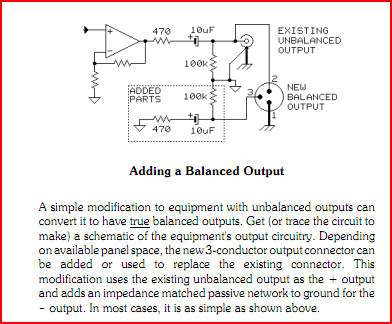ForthMonkey said:
I wouldn't use IC2A at all, just connect the 22Ω resistor from ground to pin 2.
But what about balanced output? If i don't use IC2A,i can't get balanced out,right?
You can get impedance balanced which is as good as differential signal for CMRR but you loose 6dB of signal, in noise floor and headroom, so same dynamic range. Someone could argue there are 3dB improvement for using differential signals but the major noise is already in the signal and the self noise of the coupling stages shouldn't be dominant for this case. This has many advantages, is my preferred circuit since it's the cheaper, simpler, and behaves perfectly as balanced and unbalanced source as long as you use the same pin for hot in the receiver, which is usually the case. Using the purposed circuit could create higher THD when working with unbalanced receivers having the output of the opamps shorted and 6dB loss in level. This is something has been discussed so many times I don't want to go through again, look around about some discussions in what is balanced, impedance balanced, differential, etc. I remember I've made many comments on it, also JR and many others around.
About all circuit,i like design.I'm using original circuit for my other gears.Working good.Just i want to add 2520 to this circuit.
You could replace the opamps for 2520, almost direct replace, take care for stability and compensation. There is nothing way better in a 2520 than in a good IC, the main difference which nobody can discuss is the driving capability but you usually don't need it. If you want for something more APIsh you should consider at least a complete output stage of it's kind, with the RC+transformer output. This transformers are quite easy to build, M6 core which is cheap and easy to get and no many turns, about 300 or 400 IIRC of multifilar wire for which you could use multiple single wires wiring them together. I've made a couple of those with great results and pretty close matching measurements, I used 3 wires instead of the 4 it takes so a few more turns could fit easily and only 3.5dB of headroom is lost of it's massive one, which isn't a practical way to use it feeding the converters they are going to go into so not a problem anyway, or I should go for an attenuator, which probably I need anyway. I missed to measure the parasitic inductance of the true one when I had the chance but I have plenty data on it, including losses and inductance at various frequencies and interwinding capacitance. It only took me a few bux and about an hour of winding to get this transformers working to get pretty close values to the original one, at least the ones I've measured which aren't all the ones I have available. Using a transformer you get a balanced output which is floating also which is a major advantage, and probably the best way to interface the world without having to worry about what's connected on the other side, balanced, unbalanced, floating, referenced to a crappy ground, not so good CMRR, etc.
JS






















![Electronics Soldering Iron Kit, [Upgraded] Soldering Iron 110V 90W LCD Digital Portable Soldering Kit 180-480℃(356-896℉), Welding Tool with ON/OFF Switch, Auto-sleep, Thermostatic Design](https://m.media-amazon.com/images/I/41gRDnlyfJS._SL500_.jpg)











